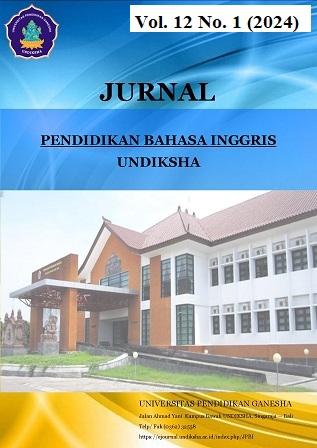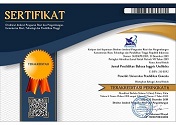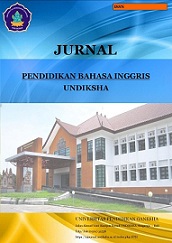English for Children: Teaching Material Model for Students of Primary School Teacher Education
DOI:
https://doi.org/10.23887/jpbi.v12i1.80938Keywords:
Model bahan ajar, English for Children, Pendidikan Guru Sekolah DasarAbstract
To improve the quality of English learning in English courses for children, students need learning resources that can improve language skills in accordance with the characteristics and needs of students as prospective English teacher in Primary School. The research aims to develop a model of teaching materials for the English for Children course in accordance with the needs of students in the Primary School Teacher Education Study Program. The research was designed using an R&D development model. This research used test subjects by carrying out validity tests on teaching materials experts, material experts, the responses of ten students in small group trials and twenty-five students in large group trials. Data was collected using a questionnaire instrument and analyzed descriptively, quantitatively and qualitatively. The research shows that the teaching material products from chapters 1 to chapter 8 are sequentially: 1) English theoretical concepts related to teaching children; 2) the concept of developing an English learning plan for children; 3) the concept of children's characteristics in learning English; 4) the concept of teaching four English skills (listening, speaking, reading, writing); 5) the concept of teaching through songs; 6) the concept of teaching through stories; 7) the concept of teaching through games; and 8) the concept of technology-assisted teaching. The results of the validator of teaching material experts, material experts and the results of student responses in small and large group trials are categorized as very valid so that English for Children teaching materials are suitable for use.
References
Afriana, J., Permanasari, A., & Fitriani, A. (2016). Implementation Project-Based Learning Integrated STEM to Improve Scientific Literacy Based on Gender. Jurnal Inovasi Pendidikan IPA, 2(2), 202–212. https://doi.org/10.21831/jipi.v2i2.8561.
Basyoni, A., Bee, M., S., H., Seng, G., & H. (2020). The effectiveness of using students’ created digital storytelling in enhancing Saudi ninth graders’ critical listening skills. Journal of Education and Social Sciences, 16(1), 58–72. https://doi.org/https://www.jesoc.com/wp-content/uploads/2020/12/JESOC16-030.pdf.
Bosica, J., Pyper, J. S., & MacGregor, S. (2021). Incorporating problem-based learning in a secondary school mathematics preservice teacher education course. Teaching and Teacher Education, 102, 103335. https://doi.org/10.1016/j.tate.2021.103335.
Century, J., Ferris, K. A., & Zuo, H. (2020). Finding time for computer science in the elementary school day: a quasi-experimental study of a transdisciplinary problem-based learning approach. International Journal of STEM Education, 7(1). https://doi.org/10.1186/s40594-020-00218-3.
Cong, W., & Li, P. (2022). The Relationship Between EFL Learners’ Communication Apprehension, Self-Efficacy, and Emotional Intelligence. Frontiers in Psychology, 13, 294. https://doi.org/10.3389/FPSYG.2022.847383/BIBTEX.
Cooper, A. C., & Sánchez, B. (2016). The roles of racial discrimination, cultural mistrust, and gender in Latina/o youth’s school attitudes and academic achievement. Journal of Research on Adolescence, 26(4), 1036–1047. https://doi.org/10.1111/jora.12263.
Dzo’ul Milal, A., Rohmah, Z., Kusumajanti, W., Basthomi, Y., Sholihah, D. N., & Susilowati, M. (2020). Integrating character education in the english teaching at islamic junior high schools in Indonesia. Teflin Journal, 31(1). https://doi.org/10.15639/teflinjournal.v31i1/88-107.
Eriyanti, R. W. (2018). Pengembangan Bahan Ajar Keterampilan Berbicara Interaktif Bagi Mahasiswa (Vol. 3, Issue 1). Jurnal Keilmuan Bahasa. https://doi.org/10.22219/kembara.v3i1.4381.
Garton, S., & Copland, F. (2018). The Routledge handbook of teaching English to young learners. Routledge.
Hertiki. (2018). Developing English Teaching Materials for Young Learners. JET: Journal of English Teaching, 3(1), 29–39. https://doi.org/10.36456/jet.v3.n1.2018.1541.
Kaptiningrum, P. (2024). Pengembangan Bahan Ajar English for Islamic Education untuk Menunjang Pemahaman Reading dan Grammar Bagi Mahasiswa PAI IBN Tegal. Tarbawiyah: Jurnal Ilmiah Pendidikan, 8(1), 1–1. https://doi.org/10.32332/tarbawiyah.v8i1.9326.
Komala, I., & Nugraha, A. (2022). Pendidikan Seni dan Kurikulum Merdeka Belajar: Tuntutan bagi Guru di Sekolah Dasar. Jurnal BELAINDIKA (Pembelajaran Dan Inovasi Pendidikan), 4(3), 122 – 134. https://doi.org/10.52005/belaindika.v4i3.114.
Lash, M., Madrid Akpovo, S., & Cushner, K. (2020). Developing the intercultural competence of early childhood preservice teachers: preparing teachers for culturally diverse classrooms. Journal of Early Childhood Teacher Education, 00(00), 1–22. https://doi.org/10.1080/10901027.2020.1832631.
Makrifah, I. A., Saifudin, A., & Sa’diyah, L. (2024). Pengembangan Bahan Ajar Matakuliah Advanced Grammar Berbasis Communicative Grammar. Jurnal Pendidikan : Riset Dan Konseptual, 8(2), 276–282. https://doi.org/10.28926/riset_konseptual.v8i2.899.
Mardiana, H. (2020). Lecturers’ Adaptability to Technological Change and Its Impact on The Teaching Process. JPI (Jurnal Pendidikan Indonesia), 9(2), 275–289. https://doi.org/10.23887/jpi-undiksha.v9i2.24595.
Naghdipour, B. (2022). ICT-enabled informal learning in EFL writing. Journal of Second Language Writing, 56. https://doi.org/10.1016/j.jslw.2022.100893.
Ninsiana, W., & Nawa, A. T. (2019). Analisis Kebutuhan Bahasa Inggris Mahasiswa Jurusan Ekonomi.
Nursalim. (2020). Penerapan Metode Pembelajaran Simulasi untuk Meningkatkan Aktivitas dan Prestasi Belajar Mata Kuliah TEYL Mahasiswa Semester VI Pendidikan Bahasa Inggris FKIP Universitas Pendidikan Muhammadiyah Sorong. Jurnal Pendidikan, 8(2). https://doi.org/10.36232/pendidikan.v8i2.461.
Nurul Aini, A., Salim, H., & Anesty Mashudi, E. (2023). Kepercayaan Diri Calon Pendidik AUD dalam Berbicara Bahasa Inggris pada Kegiatan English Credential Camp. Murhum : Jurnal Pendidikan Anak Usia Dini, 4(1), 321–334. https://doi.org/10.37985/murhum.v4i1.216.
Ota, M. K. (2018). Developing Communicative Learning Materials for Teaching English as a Foreign Language to Students of Elementary Teacher Study Program of Flores University of East Nusa Tenggara. Jurnal Pendidikan Bahasa Inggris Indonesia, 6(1), 1–12. https://doi.org/10.23887/jpbi.v6i1.2707.
Öz, H. (2014). Pre-service English Teachers’ Perceptions of Web-based Assessment in a Pedagogical Content Knowledge Course. Procedia - Social and Behavioral Sciences, 141, 45–58. https://doi.org/https://doi.org/10.1016/j.sbspro.2014.05.010.
Puspita, D. R., & Rosnaningsih, A. (2023). Analisis Kebutuhan Mahasiswa dalam Mengembangkan Bahan Ajar English for Children. Edukasi: Jurnal Pendidikan, 21(1), 27–40. https://doi.org/10.31571/edukasi.v21i1.5474.
Rahman, M. (2015). English for Specific Purposes (ESP): A Holistic Review. Universal Journal of Educational Research, 3(1), 24–31. https://doi.org/10.13189/ujer.2015.030104.
Ramadhani, S., & Izar, S. L. (2022). Pengembangan Bahan Ajar Mata Kuliah Bahasa Inggris Dasar dengan Model Kooperatif Learning Prodi PGSD FKIP UMSU. Jurnal Basicedu, 6(1), 1430–1434. https://doi.org/10.31004/basicedu.v6i1.1884.
Rofi’ah, S., Widiarini, W., Suharto, R., & Makrifah, I. (2021). Studi Kegiatan Fun With English Siswa Kelas VII dan VIII Madrasah Tsanawiyah Nahdlatul Ulama Slorok Kecamatan Garum Kabupaten Blitar. Jurnal Pengabdian Dan Pemberdayaan Nusantara (JPPNu), 3(2), 116–129. https://doi.org/10.28926/jppnu.v3i2.58.
Rohmah, F. N., & Bukhori, I. (2020). Pengembangan Media Pembelajaran Interaktif Mata Pelajaran Korespondensi Berbasis Android Menggunakan Articulate Storyline 3. ECOEDUCATION (Economic & Education Journal), 2(2), 169–182. https://doi.org/10.33503/ecoducation.v2i2.892.
Saifuddin, F., Dwi, L., & Ardiansyah, S. (2021). Analisis Kebutuhan (Need Analysis) Mata Kuliah Bahasa Inggris Terhadap Mahasiswa Sistem Informasi Universitas Nahdlatul Ulama Nusa Tenggara Barat. Jurnal Riset Intervensi Pendidikan (JRIP, 3(2). http://journal.rekarta.co.id/index.php/jrip/.
Saifudin, A., & Mubarok, T. A. (2020). Pengembangan Buku Ajar Mata Kuliah Writing Berbasis Media Sosial Storybird di Program Studi Pendidikan Bahasa Inggris Universitas Nahdlatul Ulama Blitar. Briliant: Jurnal Riset Dan Konseptual, 5(4). https://doi.org/10.28926/briliant.v5i4.550.
Sakkir, G., Dollah, S., & Ahmad, J. (2020). Students’ Perceptions toward Using YouTube in EFL Classrooms. Journal of Applied Science, Engineering, Technology, and Education, 2(1), 1–10. https://doi.org/10.35877/454ri.asci2125.
Santos, A., Wang, W., & Lewis, J. (2018). Emotional intelligence and career decision-making difficulties: The mediating role of career decision self-efficacy. Journal of Vocational Behavior, 107(2017), 295–309. https://doi.org/10.1016/j.jvb.2018.05.008.
Setyaningrum, R. W., & Purwati, O. (2020). Projecting the implementation feasibility of clil approach for teyl at primary schools in indonesia. JEES (Journal of English Educators Society), 5(1), 23–30. https://doi.org/10.21070/jees.v5i1.352.
Shalatska, H. M., Zotova-Sadylo, O. Y., & Muzyka, I. O. (2020). Moodle course in teaching English language for specific purposes for masters in mechanical engineering. CEUR Workshop Proceedings, 2643, 416–434. https://doi.org/10.55056/cte.378.
Suherman, W. S., Dapan, G., & Muktiani, N. R. (2019). Development of A Traditional Children Game Based Instructional Model to Optimize kindergarteners’ fundamental motor skill. Cakrawala Pendidikan, 38(2), 356–365. https://doi.org/10.21831/cp.v38i2.25289.
Ulya, N., & Na’imah. (2022). Peran Bahan Ajar dalam Pengenalan Bahasa Inggris pada Anak Usia Dini. Obsesi: Jurnal Pendidikan Anak Usia Dini, 6(5), 5191–5199. https://doi.org/10.31004/obsesi.v6i5.2925.
Wahyuni, D., Djatmika, E. T., Widjaya, S. U. M., & Wahyono, H. (2021). Caring economics learning to develop caring attitude among high school students. Cakrawala Pendidikan, 40(2), 345–358. https://doi.org/10.21831/cp.v40i2.38658.
Wu, R., Wu, R., & Lu, J. (2014). A practice of reading assessment in a primary classroom. Theory and Practice in Language Studies, 4(1). https://doi.org/10.4304/tpls.4.1.1-7.
Wulandari, R., Utaminingsih, S., & Kanzunnudin, M. (2020). Development of Class VI Elementary School Thematic Teaching Materials Based Local Wisdom. Journal of Education Technology, 4(3), 296–301. https://doi.org/10.23887/jet.v4i3.28457.
Yulientinah, D., Juwita, R., & Resdiana, W. (2020). Identifikasi Analisis Kebutuhan Pembelajaran Bahasa Inggris (Non Program Studi Bahasa Inggris) Pada Mata Kuliah Bahasa Inggris Khusus/English for Spesific Purposes (ESP) di Program Studi D4 Akuntansi Keuangan Politeknik Pos Indonesia. Jurnal Competitive, 15(1). https://doi.org/10.36618/competitive.v15i1.625.
Zidni, Z. F. K. S., Widiarini, & Mubarok, T. A. (2023). Developing Vocabulary Digital Pocket Book to Online Business and Marketing (OBM) Students at Vocational High School Level. English Education: Journal of English Teaching and Research, 8(1), 30–42. https://doi.org/10.29407/jetar.v8i1.18755.
Downloads
Published
Issue
Section
License
Copyright (c) 2024 puspitadayu puspita

This work is licensed under a Creative Commons Attribution-ShareAlike 4.0 International License.
Authors who publish with the Jurnal Pendidikan Bahasa Inggris Undiksha agree to the following terms:- Authors retain copyright and grant the journal the right of first publication with the work simultaneously licensed under a Creative Commons Attribution License (CC BY-SA 4.0) that allows others to share the work with an acknowledgment of the work's authorship and initial publication in this journal
- Authors are able to enter into separate, additional contractual arrangements for the non-exclusive distribution of the journal's published version of the work (e.g., post it to an institutional repository or publish it in a book), with an acknowledgment of its initial publication in this journal.
- Authors are permitted and encouraged to post their work online (e.g., in institutional repositories or on their website) prior to and during the submission process, as it can lead to productive exchanges, as well as earlier and greater citation of published work. (See The Effect of Open Access)













